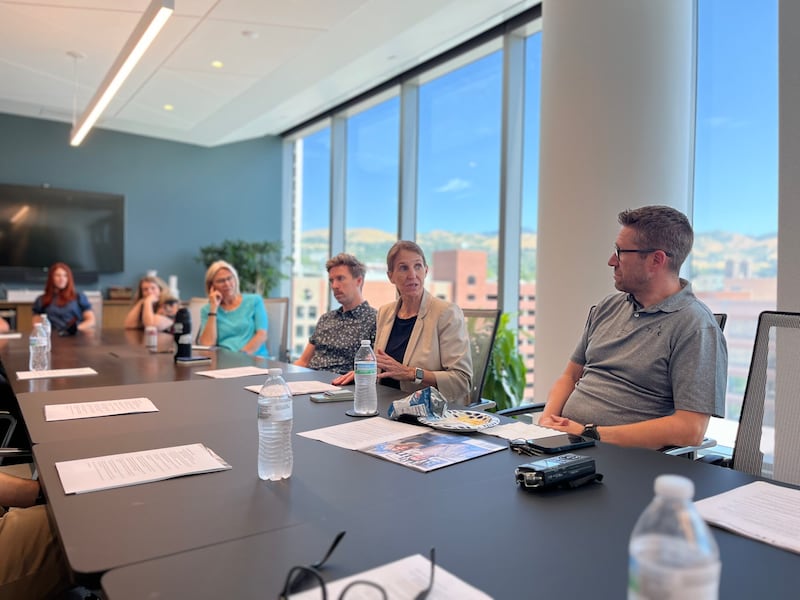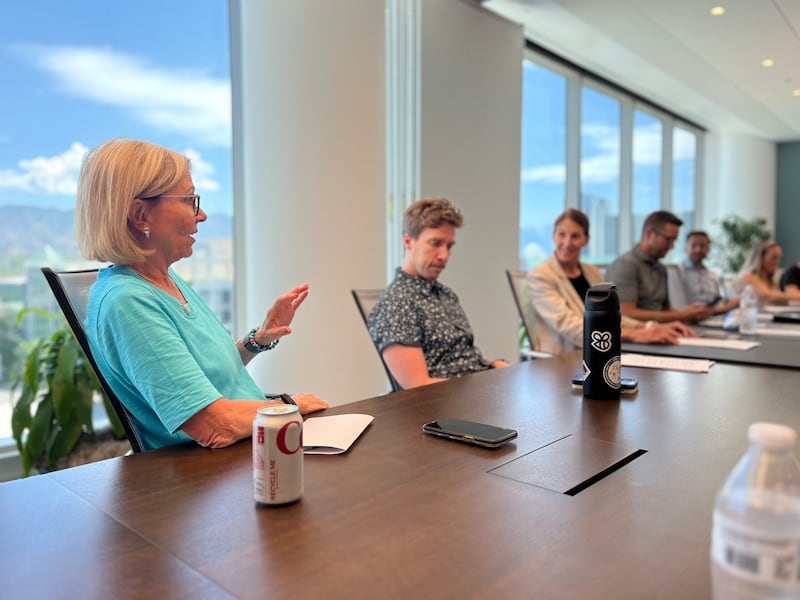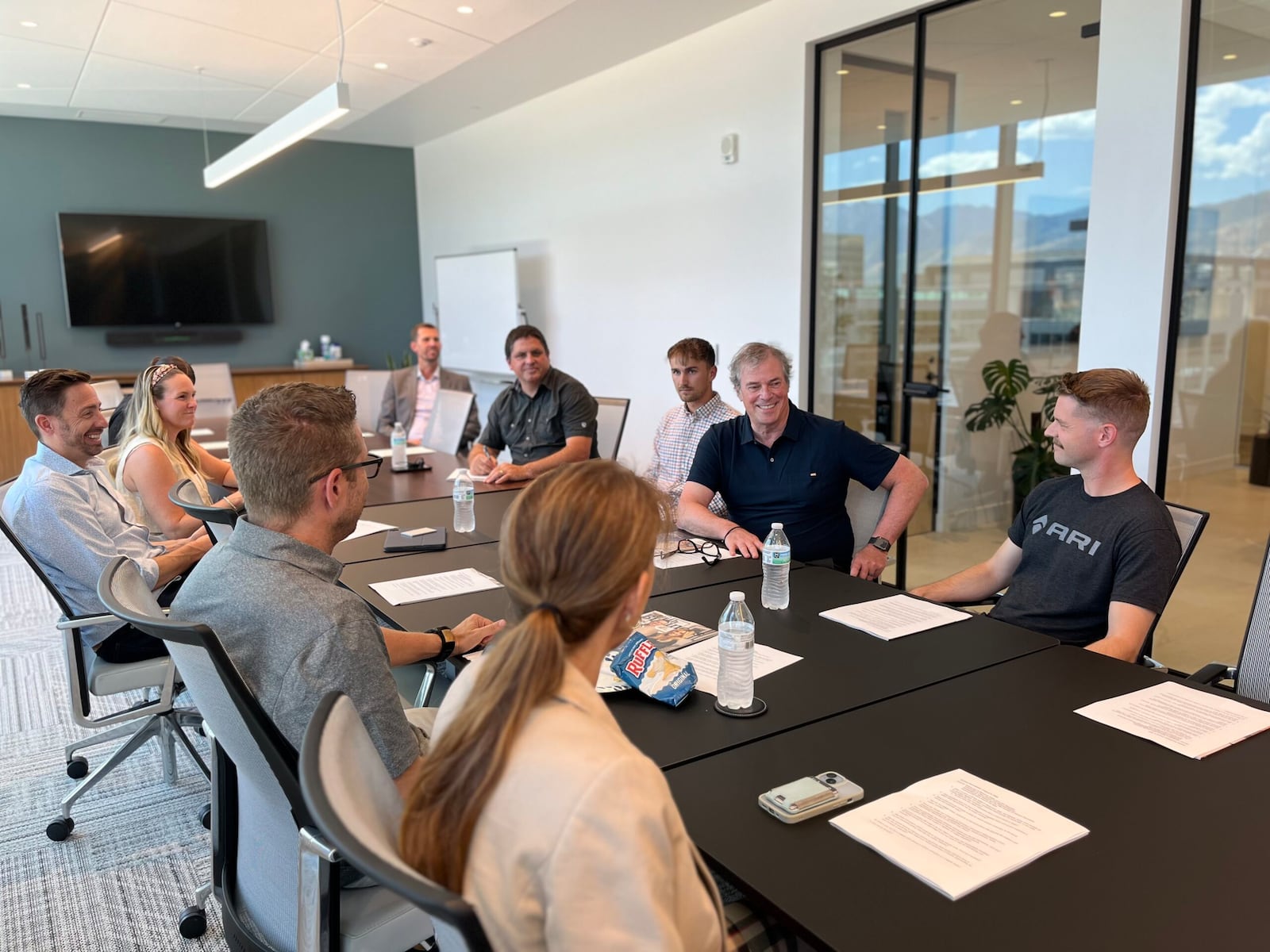, participants discussed increasing outdoor participation, designing with inclusivity in mind, Utah’s field testing advantage and more.
What trends are you seeing in outdoor participation across the state and nation?
Patrick Morrison | Recreation Program Director | Utah Division of Outdoor Recreation
More people are going outside, but they’re spending less time there. … For the first time, more women are recreating than not. Non-white males are finding more opportunities to recreate, and I think it’s about diversity of opportunities. The lens of what we see as recreation has really opened up.
Raelene Davis | VP, Marketing | Ski Utah
We were hovering around 5 million skier visits per year. Then the pandemic hit, and we dropped to a bit less than that. The winter before last, when we had 903 inches of snow, we exceeded 7 million. This past season, we dropped back to 6.75 million, with about 60 percent of those being destination visitors.
We had two to three years of strong sales, during which everybody seemed to discover the outdoors and spent money on investment gear — tents, sleeping bags, skis and apparel. Now, things have leveled off for specialty retailers. How are your consumer sales versus retail sales?
Colleen Burns | Senior Director, Owned Brands | Backcountry
When COVID-19 started, bike was the first category to really take off, then hard goods followed, then soft goods. Once the bubble burst, bike was the first one to go down, then hard goods followed by soft goods. We are seeing bike turn around now and climb up. … We are seeing the trend of more women buying in the industry. We’re seeing success for brands like THE GREAT. Outdoors and FP Movement. … We’re trying to understand what they are doing to capture customers. People aren’t buying as many ski jackets anymore, so the question is, what are they buying, and how are we capitalizing on that?
Mike May | Co-Founder, President & COO | Pingora
We’re continuing the deadstock story that my co-founder CJ Whittaker helped start at Cotopaxi. It’s been tough math for us to figure out how to match the right technical fabric that’s still good with the colors that are in season. But I’m new to the industry, and one thing that’s stood out to me is how much extra fabric is out there in the world; how much excess and buying deep and over-buying. There’s so much extra product in the system.
Matt Sterbenz | GM, Wintersports | Checkerspot, Inc.
We launched WNDR Alpine in 2019. We couldn’t meet minimums overseas, so we had to make things ourselves. … It hasn’t gotten easier since then; it’s only gotten more complicated. There’s been an overwhelming narrative of how complicated it is to access skiing around here, even though there’s such a plethora of it. … Our infrastructure didn’t grow 20 percent, but our skier visits did. Backcountry skiers are struggling to figure out how to access public land. I don’t point fingers, and I don’t think it isn’t reconcilable, but we’re experiencing some growing pains. … It’s going to be critical to Utah’s business economy to rightfully harmonize all of these activities and connect public land access with the private sector of hospitality to keep land open and public.

What strategies have you found effective in engaging your customers?
Jordan Washburn | Director, Sales | Ari Bikes
The outdoor industry can have a very elitist mentality. Like, “Oh, you’re new to biking, skiing, camping, hiking, whatever? You have no business looking at this bike.” But we look at it like we’re just here to help guide them. If someone is new and wants to spend $5,000 on a bike, let them do so, but also help guide them to the proper one. Whether you’re new or a pro or somewhere in between, we’re here to help.
Something else we’ve observed: The used market is very flooded right now. Lots of brands that may have over-ordered during COVID are discounting with major sales, which then forces everybody else to discount with major sales. It’s annoying for us; we’re already 30-40 percent less than the big brands out there, but people only see the big discount. It forces a lot of us to also do discounts. … That ties into innovation because people will buy new if there’s a reason to buy new. Whereas a lot of brands are hunkering down trying to weather the storm right now, we’re tripling down and introducing nine new bikes and a brand evolution.
Raelene Davis | VP, Marketing | Ski Utah
Three years ago, we started Discover Winter, which is a learn-to-ski-and-ride program for ethnically diverse adults. A lot of these people are refugees or new people to Utah. … we felt that if you could get the adults [to ski], the kids would come. … The most interesting thing we discovered was that people of color don’t participate in the outdoors because they don’t have a community. They don’t have somebody who says, “Hey, come with me.” The next thing that we found was about equipment. Do you know how hard it is to find a ski or bike helmet that fits an afro or cornrows, a pair of ski pants that fit a Black woman, or a pair of goggles that fit a Pacific Islander’s or a Black person’s nose? Those are the things that the outdoor industry needs to pay attention to.
What is the Outdoor Product Design & Development program, and what is it doing to help the industry diversify?
Chase Anderson | Industry Relations & Marketing | Outdoor Product Design & Development at Utah State University
We’ve had six graduating classes. The students have a lot of flexibility in choosing different pathways. They can focus on performance apparel, soft goods and accessories, or go more of a traditional industrial design, hard goods pathway. We’ve also added some other areas, like a product development emphasis that’s more about supply chain management and sourcing, working with factories and alongside a designer. We’ve added a product management and product marketing-type emphasis. … We partnered with Salt Lake Community College (SLCC) recently. … Students can now complete two years at SLCC and then jump into year three with us and complete their four-year degree.
How can we engage new customers in seeing themselves fully enjoying the outdoors and outdoor activities?
Colleen Burns | Senior Director, Owned Brands | Backcountry
We have changed our entire marketing strategy. … you’ll see it’s a lot more playful. It’s easy for the industry to be elitist, so we’ve completely flipped the script. We’re trying to be very simple. Product details may be very standard to anyone in this room, but I recently had someone ask me what “UPF” [ultraviolet protection factor] means. We’re trying to make those things as entry-level as possible.
Jeremy McLerran | VP, Marketing | TETON
The Outdoor Industry Association participation trend report claims that 57.3 percent of all Americans age six and older are participating in outdoor activities. How many of them are pros? Probably not a very large percent. They claim participation grew by 4.1 percent just last year and that there are a record 175 million people doing outdoor activities. … It’s about creating entry-level opportunities for those individuals to try something out and start creating those communities, create a memory and say, “That was fun. I’d like to do it again. I enjoyed the pictures I took, and I enjoyed having a great story to tell when I got back in the office on Monday.”
Jordan Washburn | Director, Sales | Ari Bikes
When you’re dumbing down the experience, you don’t need to dumb down the product. In fact, you probably shouldn’t. We still focus on building our product for the pros so it can perform at that level, but we make the experience more accessible by doing critical thinking for the customer in a lot of aspects. We custom-fit all of our bikes to each individual. We don’t do women-specific bikes or men-specific bikes; we do rider-specific. We take your height, shoulder width, arm length, inseam, torso and riding style. … Let’s make the experience more accessible and easier, but the product still needs to perform at a professional level, or else you lose credibility.
Would you identify your customers as conscious consumers? What aspects of your company and products (e.g., sustainability practices, ethical practices, social responsibility) attract them to your brand over others?
Mike May | Co-Founder, President & COO | Pingora
It’s our role as outdoor brands to educate consumers. … I also think it’s successful from a marketing perspective when the longevity of a product lasts the lifetime of that consumer. Younger consumers have data at their fingertips, and you’ve got to be really transparent and authentic to connect with them. I’m concerned with the future when it comes to greenwashing and people saying things are recycled or that they’re an eco-friendly company when perhaps they aren’t.
Jason Murray | Board of Tourism Development; Owner & CEO | Southwest Adventure Tours
As an outdoor adventure company, we see the gamut between high-end customers and those who want to travel on a budget. … A lot of the time, those who are buying less expensive products are those who are newer to the outdoor market. My customers are a little bit older. They’ve been factory workers, construction workers or office workers their entire lives, and they’ve lived their lives on a budget. When it comes to buying outdoor gear, they follow that same thing. … They’re buying knockoff brands that wear out. I can’t tell you how many suitcases or bags people rip halfway through a trip because they bought the cheap ones.
Colleen Burns | Senior Director, Owned Brands | Backcountry
We are RDS-certified and RWS-certified. We’re completely PFAS-compliant because you can’t say PFAS-free. We’re fair trade, and everything’s recycled where it can be. … It’s a double-edged sword. I’m trying to get our minimums down as low as possible while making a profit for our company and the manufacturer we work with. We don’t put marketing dollars behind sustainability messaging, even though we are doing it in the background. … It costs a lot of money to keep your certifications up every year, and I don’t think the customer has any idea how much you have to pay just to say, “Yes, we are compliant here. Yes, we’re doing the right thing.”
Paul Johnson | Patent Attorney & Partner | Maschoff Brennan
If you are innovating your products, you really should be thinking about protecting those innovations. As a patent attorney, that’s what I think about day in and day out. Hopefully, you’ve got your own patent attorney and your own intellectual property (IP) counsel, and you’re protecting both technical innovations and design innovations. I used to represent a client that made water bottles. Not only did they do utility patents, but they also did a lot of design patents, and they were very active in enforcement. They were able to keep knockoffs off the market.
What new technology has your company embraced over the last half decade and why?
Jeremy McLerran | VP, Marketing | TETON
We’re using AI a lot to write copy and create blog articles. We’re using it for analyzing things, figuring out what our forecasts need to be, taking our spreadsheets and uploading them into AI and saying, “Based on the current trends, what should our forecast for next month, next year, etc., be?” We’re working on tools that allow us to say, “Based on this person’s purchase and the other things that they may have already bought from us and the location they live, what are the three hikes that we should recommend to them in an email to them to help encourage them to get out more often? What are the three camping sites that we should tell them about after they buy that tent?”
Is it an advantage to live and work in Utah for field testing your products?
Matt Sterbenz | GM, Wintersports | Checkerspot, Inc.
Absolutely. The majority of the global supply chains for wintersport hard goods are in Europe and Asia. Being able to rapidly prototype, develop and test things is obviously going to accelerate any of those lengthy timelines that otherwise exist. Manufacturing domestically obviously helps accelerate even further, but that’s not necessarily a scalable venture for all commercial purposes.
I think that, as a state, we have a much larger influence globally than we may give ourselves credit for. I go back to the Midwest, and people say to me, “Oh, he’ll know. What bike should I get? What pair of running shoes should I get?” When you’re from Utah, people just associate you with being a relative expert in outdoor recreation.
Chase Anderson | Industry Relations & Marketing | Outdoor Product Design & Development at Utah State University
The interesting thing about Utah, in addition to the field testing component, is that we have some really interesting organizations here that have a long history of product and material testing. Some of you here have probably worked with IDFL, or the International Down and Feather Testing Laboratory. They’ve been doing down and feather testing since 1978, as well as all sorts of other material testing, in addition to performing social audits on factories.
We’ve got the upcoming 2034 Winter Olympics. How do big events like these impact your brand awareness or provide opportunities for your companies to take part?
Francois Goulet | President | Rossignol Group
If I look at the legacy from 2002 and the facilities that stayed, I think Utah is a best-in-class example of supporting young athletes. … A lot of kids from Utah are performing at a high level because of the facilities and the programs that exist here.
Raelene Davis | VP, Marketing | Ski Utah
It’s 17 days of the biggest infomercial we could never buy as a winter industry in Utah. … One of the best quotes that came from the International Olympic Committee announcement of the 2034 games was when Gov. Spencer Cox said, “In 2002, Salt Lake needed the Olympics, but in 2034, the Olympics needs Salt Lake.” At some point, we needed the Olympics to help us brand Utah as a premier ski, snowboard and winter destination. Now, the Olympics needs us because we have the facilities, the community, the volunteers, all of those things that are necessary to have a successful Games.
What is your No. 1 tip to engage more people in outdoor recreation on a regular basis?
Patrick Morrison | Recreation Program Director | Utah Division of Outdoor Recreation
Find somebody you can mentor and be intentional in how you mentor.
Jordan Washburn | Director, Sales | Ari Bikes
Help clarify definitions, educate, and be helpful guides.
Francois Goulet | President | Rossignol Group
Diversity in the industry will start with people within our industry who come from diverse backgrounds.
Jason Murray | Board of Tourism Development; Owner & CEO | Southwest Adventure Tours
Encourage community groups and provide more opportunities for people to be together in the outdoors.
Mike May | Co-Founder, President & COO | Pingora
Design with true inclusivity in mind.
Jeremy McLerran | VP, Marketing | TETON
Bring your kids. I’ve got five kids, and I try to take them outside as much as I possibly can. That helps bring the next generation of outdoor enthusiasts to the market.


